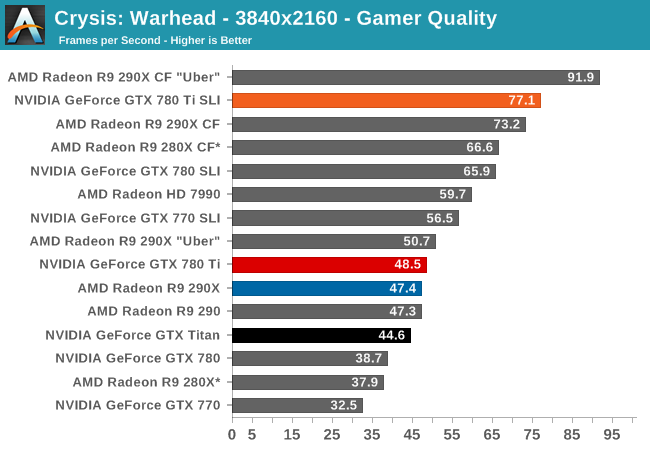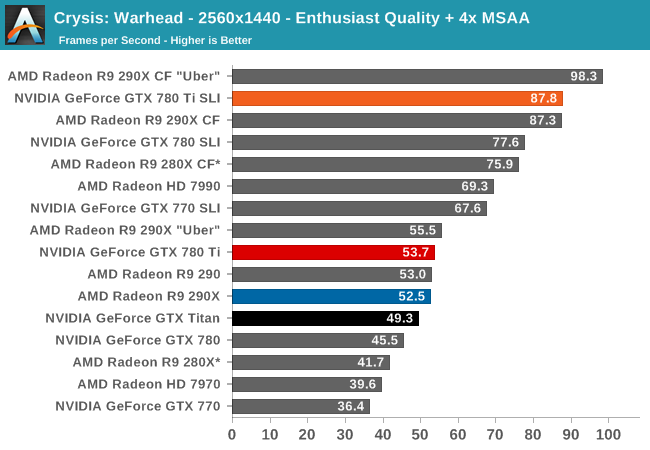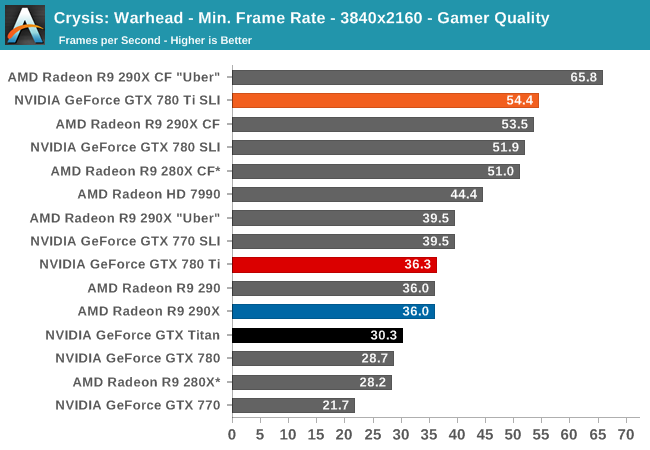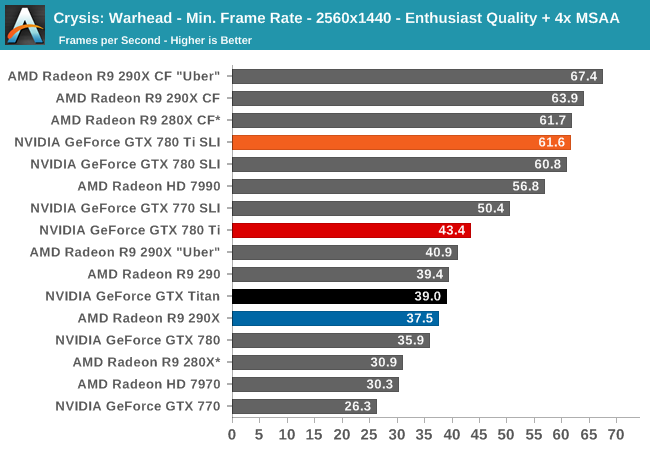The NVIDIA GeForce GTX 780 Ti Review
by Ryan Smith on November 7, 2013 9:01 AM ESTCrysis: Warhead
Up next is our legacy title for 2013/2014, Crysis: Warhead. The stand-alone expansion to 2007’s Crysis, at over 5 years old Crysis: Warhead can still beat most systems down. Crysis was intended to be future-looking as far as performance and visual quality goes, and it has clearly achieved that. We’ve only finally reached the point where single-GPU cards have come out that can hit 60fps at 1920 with 4xAA, never mind 2560 and beyond.


Whereas Battlefield 3 is a game that traditionally favors NVIDIA, Crysis: Warhead has generally favored AMD in this generation, leading to an uphill battle for NVIDIA. 290X was able to beat GTX Titan here at 2560, but with the additional performance offered by the GTX 780 Ti NVIDIA is once again at the top, though only by a margin of under 2fps (or 2%). Otherwise compared to NVIDIA’s other cards, Crysis: Warhead is another consistent game for GTX 780 Ti, with NVIDIA’s latest card beating GTX Titan and GTX 780 by 9% and 18% respectively.
Moving on, even when we double up on cards the GTX 780 Ti and 290X remain close. At 2560 it’s a virtual tie at 87fps apiece, while at 4K the GTX 780 Ti SLI takes a slight lead.


As for our minimum framerates under Crysis: Warhead, NVIDIA does end up breaking the deadlock here with a slight performance advantage for the GTX 780 Ti, beating the 290X by several percent, pushing its minimum framerate above 40fps.










302 Comments
View All Comments
fewafwwaefwa - Thursday, November 7, 2013 - link
sterven.looncraz - Thursday, November 7, 2013 - link
When game producers author the games they will do it with a mind towards Mantle and exploiting the AMD GPU characteristics exposed by Mantle on PCs for their console games.When creating portable software you create as thin of an abstraction layer as possible, that layer will now be much closer to the metal with unoptimized DirectX alternatives being manually added. That could very well mean that AMD hardware will have a noticeable advantage on PCs and game producers will only need to do a little extra work to become compatible with other DX-10/11 compatible video cards on Windows/Linux - so nVidia will become something of a "don't forget about me!" rather than "let's build to a generic platform and pull in the nVidia GPU extensions..."
Basstrip - Friday, November 8, 2013 - link
I think they've ALWAYS programmed directly to the core. I think it's safe to assume that the processes translate fairly well and that although they might not be the same, they are similar.It just seems so economic to streamline the whole process. Less of a headache than to constantly try optimize things for multiple platforms.
AMD chips on consoles may not be able to support mantle on the hardware side but programming for consoles and for pc will definitely NOT be 2 completely different things.
elajt_1 - Friday, November 8, 2013 - link
Something I read on Extremetech: Feedback we’ve gotten from other sources continues to suggest that Microsoft’s low-level API for the Xbox One is extremely similar to Mantle, and the difference between the two is basically semantic. This doesn’t square very well with Microsoft’s own statements; we’ll continue to investigate.http://www.extremetech.com/gaming/168671-xbox-one-...
klmccaughey - Monday, November 11, 2013 - link
The difference is a couple of header files. Izzy Wizzy! And you have your API calling code in Xbox transferable to a PC, the header files compile the API's to Mantle API - but both API's are essentailly the same. It couldn't be easier.polaco - Friday, November 8, 2013 - link
The point of mantle I think is to provide an easy way to port from PC to console or Console to PC. So giving the possibility to allow an easier cross compilation.L33T BEANS - Friday, November 8, 2013 - link
Basing someones intelligence on a single statement is unwise.Totally - Sunday, November 10, 2013 - link
Reading these comments makes me wonder, if these people slinging mantle around like a buzzword actually know what it does, because going by the comments alone trying to pitting it against g-sync they clearly don't. Mantle is as relevant to gamers as Cuda is. Yes it does have a direct impact but the benefits aren't for the end user.klmccaughey - Monday, November 11, 2013 - link
You do not understand. The API on the consoles is basically "Mantle". Mantle copies verbatim the API calls for the consoles. They just call it the API on the console. Port the code across, change a few headers, and you have your Mantle calls ;)MonkeyM - Sunday, November 10, 2013 - link
They will sell DIY kits, you don't need a new monitor, as per the press conference.